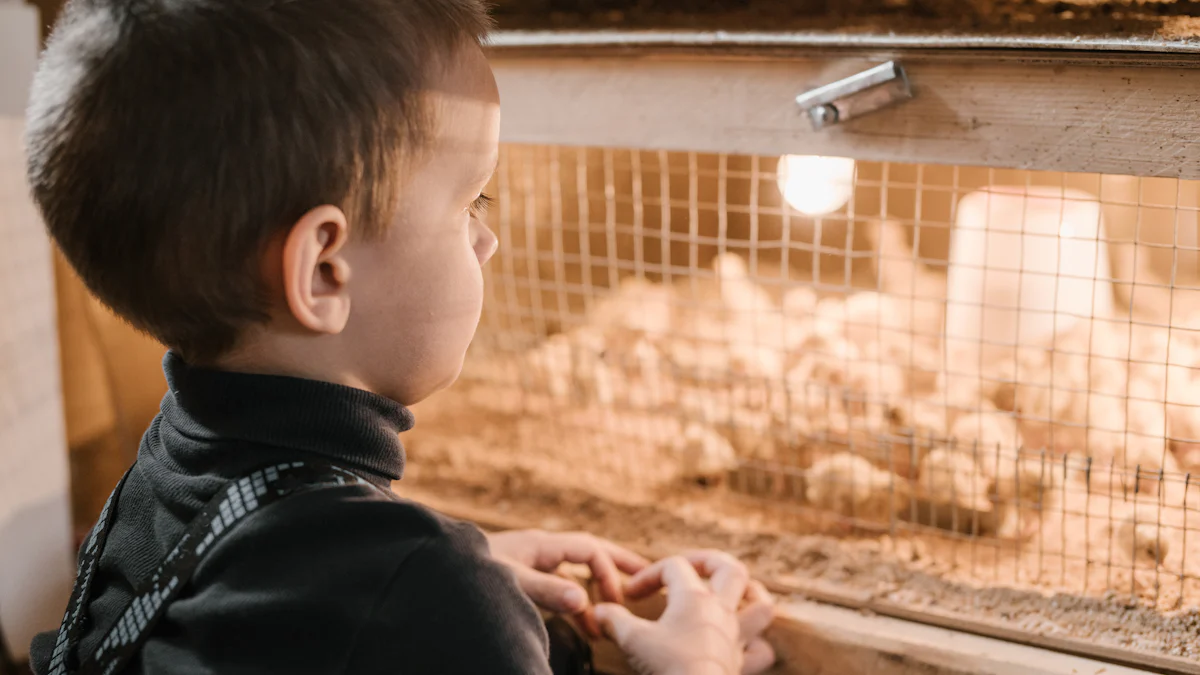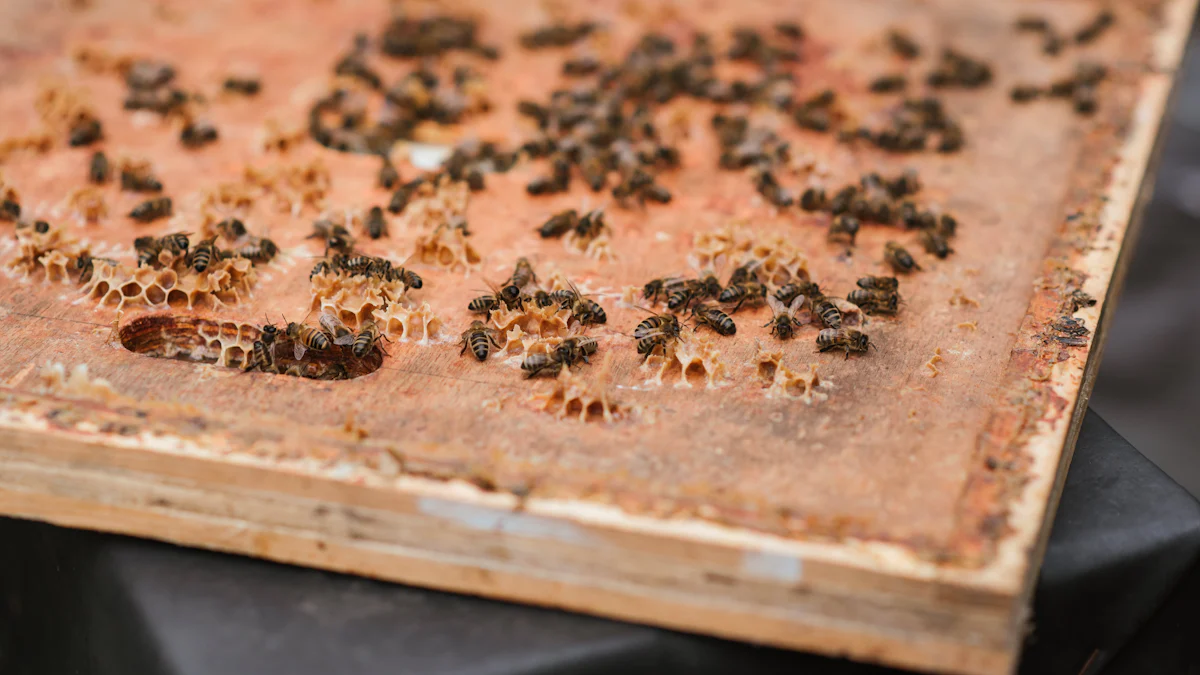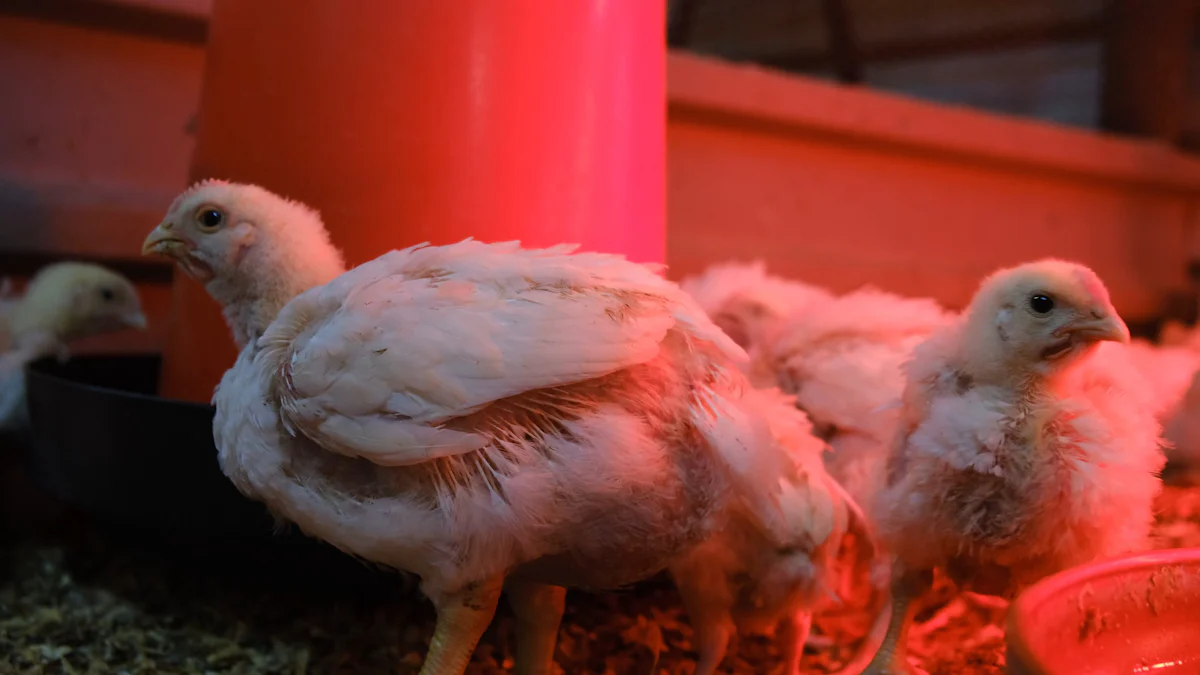
Raising mealworms for your poultry offers a treasure trove of benefits. These wriggly wonders pack a punch with their nutrient profile, rivaling traditional feeds like fish and soybean meal. Imagine your chickens clucking with joy as they feast on these protein-rich morsels! Mealworms not only enhance egg production but also improve the flavor and size of the eggs. They promote natural foraging behavior, keeping your flock active and healthy. Plus, incorporating bulk mealworms for chickens into their diet can be a cost-effective and sustainable choice, making your poultry farming adventure both rewarding and economical.
Key Takeaways
- Raising mealworms provides a nutrient-rich food source for poultry, enhancing growth, egg production, and overall health.
- Setting up a mealworm farm requires a suitable container, bedding materials like wheat bran, and a starter colony of around 1,000 mealworms.
- Maintaining optimal conditions, including temperature (70-80°F) and humidity, is crucial for the health and productivity of your mealworm colony.
- Mealworms thrive on a varied diet; provide them with oats, wheat bran, and fresh vegetables for moisture and nutrition.
- Harvest mature mealworms when they are plump and golden-brown to maximize nutritional benefits for your chickens.
- Avoid common mistakes such as overcrowding, improper ventilation, and neglecting the nutritional needs of your mealworms to ensure a successful farm.
- Incorporating mealworms into your chickens’ diet is a cost-effective and sustainable choice, promoting natural foraging behavior and enhancing their well-being.
Setting Up Your Mealworm Farm

Embarking on the journey of mealworm farming is like opening a treasure chest of possibilities for your poultry. Let’s dive into the essentials you’ll need to get started.
Necessary Materials
Containers and Bedding
First, you need a cozy home for your mealworms. Choose a container that is solid and smooth inside. Options include shoe storage bins, small aquariums, or plastic containers with vented lids. These containers should be made of non-rotting materials like glass or plastic. A multi-tier system with several drawers can maximize space and efficiency. For bedding, wheat bran, oatmeal, or cereal crumbs work wonders. Store-bought bran or oats are excellent choices. You can also add a raw potato cut in half to provide both food and moisture.
Mealworm Starter Colony
Next, you’ll need a Mealworm Starter Colony. Begin with around 1,000 mealworms. This number provides a solid foundation for growth. Mealworms thrive on a diet rich in cereals and carbohydrates, supplemented with protein, fruits, or vegetables. Ensure good airflow and appropriate light cycling to keep them happy and healthy.
Food and Moisture Sources
Mealworms love a varied diet. Offer them oats, wheat bran, and vegetables like carrots for moisture. Keep the larvae at least an inch below the top of the container to prevent any daring escapes. A large surface area in the container helps them thrive. Some people find success keeping their mealworm farms in places like a laundry room, garage, or basement.
Initial Setup
Preparing the Container
Now, let’s prepare the container. Line it with 1-2 inches of your chosen bedding. This layer serves as both a home and a food source. Ensure the container has a vented lid to allow for proper ventilation. Place the container in a warm spot, ideally between 70-80°F (21-27°C), to create a comfortable environment for your mealworms.
Introducing the Mealworms
With the container ready, it’s time to introduce your mealworms. Gently place them on the bedding. Watch as they burrow and explore their new home. Remember, patience is key. It typically takes about three months to harvest your first batch of mealworms. But once they start multiplying, you’ll have a continuous supply of bulk mealworms for chickens, enhancing their diet and overall health.
Maintaining Your Mealworm Colony
Congratulations! You’ve set up your mealworm farm. Now, it’s time to ensure your colony thrives. Maintaining optimal conditions and providing the right care will keep your mealworms healthy and productive.
Optimal Conditions
Temperature and Humidity
Your mealworms love warmth. Keep their environment between 70-80°F (21-27°C). This temperature range encourages growth and reproduction. Too cold, and they slow down. Too hot, and they might not survive. Humidity matters too. Aim for a moderate level. Too dry, and they dehydrate. Too moist, and mold can grow. A simple hygrometer can help you monitor these conditions.
Light and Ventilation
Mealworms prefer the dark. They thrive in low-light conditions. Avoid direct sunlight. It can overheat them. Ensure proper ventilation in their container. Fresh air prevents mold and keeps them healthy. A vented lid or small holes in the container work well. Just make sure the holes are small enough to prevent escapes.
Feeding and Watering
Types of Feed
Mealworms aren’t picky eaters. They enjoy a variety of foods. Oats, wheat bran, and cereal crumbs make excellent choices. These provide essential nutrients. You can also add small amounts of fruits and vegetables. Carrots, apples, and potatoes are favorites. They offer moisture and variety. Remember, balance is key. Too much fresh produce can lead to spoilage.
Providing Moisture
Mealworms need moisture to thrive. Fresh vegetables like carrots or potatoes work wonders. Place a few slices in the container. Replace them regularly to prevent mold. Avoid water dishes. They can drown your mealworms. Instead, rely on the moisture from fruits and veggies. This method keeps your colony hydrated and happy.
By maintaining these conditions, you’ll have a thriving mealworm colony. Your chickens will benefit from the nutritious bulk mealworms for chickens. They’ll grow faster, lay more eggs, and boost their immunity. Compared to traditional feed, mealworms offer a cost-effective and sustainable option. Your poultry farming adventure just got more exciting!
Harvesting and Using Bulk Mealworms For Chickens

You’ve nurtured your mealworm colony with care, and now it’s time to reap the rewards. Harvesting mealworms at the right moment ensures your chickens receive the maximum nutritional benefits. Let’s explore how to identify mature mealworms and prepare them for your flock.
When to Harvest
Identifying Mature Mealworms
Spotting mature mealworms is like finding gold nuggets in a riverbed. Mature mealworms are plump, golden-brown, and about an inch long. They have a firm texture, indicating they’re packed with nutrients. At this stage, mealworms boast a rich nutritional profile, high in protein and healthy fats. These nutrients are essential for your chickens’ growth and health. Keep an eye on their color and size to ensure you harvest them at their peak.
Preparing Mealworms for Chicken Feed
Cleaning and Storing
Once you’ve gathered your mature mealworms, it’s time to prepare them for your chickens. Start by cleaning them. Gently sift through the bedding to separate the mealworms. You can use a colander or sieve for this task. Rinse them briefly under cool water to remove any remaining debris.
Next, decide whether to feed them live or dried. Live mealworms provide around 30% protein, offering complete nutrition for your chickens. However, drying them increases the protein content to about 50%, making them a concentrated source of nutrients. To dry them, spread the mealworms on a baking sheet and place them in a warm, dry area. Once dried, store them in an airtight container to maintain freshness.
Feeding your chickens bulk mealworms for chickens can significantly boost their growth rate, egg production, and immunity. Compared to traditional feed, mealworms offer a cost-effective and sustainable option. They are high in essential fats like Omega-6 and Omega-9, which contribute to your chickens’ overall health. By incorporating mealworms into their diet, you not only enhance their nutrition but also promote natural foraging behavior, keeping your flock active and happy.
Legal and Practical Considerations
Raising mealworms for your poultry can be a rewarding venture, but it’s important to navigate the legal landscape and practical aspects to ensure success. Let’s explore the key considerations you need to keep in mind.
Understanding Legalities
Local Regulations
Before diving into mealworm farming, you must familiarize yourself with local regulations. Different regions have varying rules regarding insect farming and feed production. For instance, the Commission Regulation (EU) 2017/893 authorizes the use of processed animal protein derived from certain insect species, including mealworms, for feed in aquaculture systems. This regulation highlights the safety and marketability of yellow mealworm larvae within the EU. However, you should check with your local agricultural or environmental authorities to ensure compliance with any specific requirements in your area. Understanding these regulations will help you avoid potential legal issues and ensure your mealworm farm operates smoothly.
Practical Tips for Success
Common Mistakes to Avoid
Embarking on the journey of mealworm farming can be exciting, but it’s essential to steer clear of common pitfalls. Here are some practical tips to help you succeed:
-
Overcrowding: Mealworms need space to thrive. Avoid overcrowding by using multiple containers or a tiered system. This setup ensures each mealworm has enough room to grow and prevents stress-related issues.
-
Improper Ventilation: Mealworms require proper airflow to stay healthy. Ensure your containers have vented lids or small holes for ventilation. This prevents mold growth and keeps your colony thriving.
-
Neglecting Temperature and Humidity: Mealworms thrive in warm, moderately humid environments. Keep their habitat between 70-80°F (21-27°C) and monitor humidity levels. Use a simple hygrometer to maintain optimal conditions.
-
Inadequate Nutrition: Provide a balanced diet for your mealworms. Offer a mix of oats, wheat bran, and fresh vegetables like carrots for moisture. Avoid overfeeding with fresh produce to prevent spoilage.
-
Ignoring Life Stages: Mealworms go through several life stages, including larvae, pupae, and adults. Separate pupae and adult beetles from larvae to prevent overcrowding and ensure a continuous supply of mealworms.
By avoiding these common mistakes, you’ll set your mealworm farm up for success. Your chickens will benefit from the nutritious bulk mealworms, enhancing their growth rate, egg production, and immunity. Compared to traditional feed, mealworms offer a cost-effective and sustainable option, making your poultry farming adventure both rewarding and economical.
Raising mealworms for your poultry is a game-changer. You provide your chickens with a rich source of protein and essential nutrients. This boosts their growth, enhances egg production, and strengthens their immunity. Mealworms encourage natural foraging behavior, keeping your flock active and healthy. Compared to traditional feed, bulk mealworms for chickens offer a cost-effective and sustainable option. You save money while ensuring your chickens thrive. So, why wait? Dive into mealworm farming and watch your poultry flourish like never before!
FAQ
Have you ever thought about raising mealworms for chickens?
If you have chickens, you know how much they love mealworms. It’s like chicken crack! Mealworms provide a protein-packed treat that boosts your flock’s health and happiness. They enhance growth, improve egg production, and strengthen immunity. Plus, they encourage natural foraging behavior, keeping your chickens active and engaged.
How do mealworms compare to traditional chicken feed?
Mealworms offer a cost-effective and sustainable alternative to traditional feed. They are rich in essential nutrients like protein and healthy fats. Compared to conventional feeds, mealworms can significantly boost your chickens’ growth rate and egg production. They also promote better overall health, making them a smart choice for any poultry farmer.
What is the best way to start a mealworm farm?
Starting a mealworm farm is simple. Begin with a sturdy container and line it with bedding like wheat bran or oats. Introduce a starter colony of around 1,000 mealworms. Provide them with a balanced diet of oats, wheat bran, and fresh vegetables for moisture. Maintain a warm environment between 70-80°F (21-27°C) to encourage growth.
How long does it take to harvest mealworms?
Patience is key when raising mealworms. It typically takes about three months to harvest your first batch. Once they start multiplying, you’ll have a continuous supply of mealworms for your chickens. This steady supply ensures your flock always has access to this nutritious treat.
Can mealworms be fed live or dried to chickens?
You can feed mealworms to chickens either live or dried. Live mealworms offer around 30% protein, providing complete nutrition. Drying them increases the protein content to about 50%, making them a concentrated source of nutrients. Both options are beneficial, so choose based on your preference and convenience.
Are there any legal considerations for raising mealworms?
Yes, it’s important to understand local regulations regarding insect farming. Different regions have varying rules. For example, the Commission Regulation (EU) 2017/893 authorizes the use of processed animal protein from certain insects, including mealworms, for feed in aquaculture systems. Check with local authorities to ensure compliance.
What common mistakes should I avoid when raising mealworms?
Avoid overcrowding by using multiple containers. Ensure proper ventilation to prevent mold. Maintain optimal temperature and humidity levels. Provide a balanced diet and separate different life stages to ensure a continuous supply. By steering clear of these pitfalls, you’ll set your mealworm farm up for success.
How do mealworms benefit my chickens’ health?
Mealworms are a powerhouse of nutrition. They boost growth, enhance egg production, and improve immunity. The high protein content supports muscle development, while healthy fats contribute to overall well-being. By incorporating mealworms into their diet, you ensure your chickens thrive and stay healthy.
Are there more FAQs to consider?
You now have all the information you need to grow mealworms and create a sustainable worm farm for your flock. There are just a few more FAQs to consider. Feel free to explore further and discover the joys of mealworm farming for your poultry!


